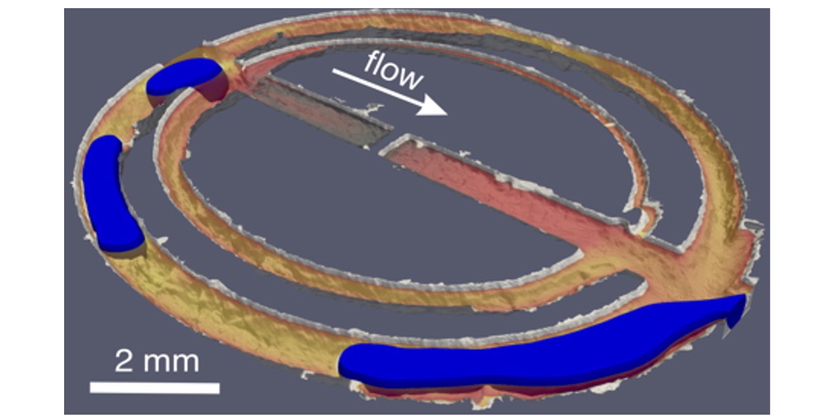Abteilung Wasserressourcen und Trinkwasser
Flüssig-Feststoff-Reaktionen in porösen Medien

Jiménez-Martínez, J., Hyman, J.D., Chen, Y., Carey, J.W., Porter, M.L., Kang, Q., Guthrie, G., and Viswanathan, H.S. (2020) Homogeneization of dissolution and enhanced precipitation induced by bubbles in multiphase flow systems. Geophys. Res. Lett., doi: 10.1029/2020GL087163
Poröse Medien sind sehr heterogene Umgebungen, in denen Prozesse auf mikroskopischen räumlichen und zeitlichen Skalen ablaufen. Die Bewegung nicht mischbarer Flüssigkeiten hat einen starken Einfluss auf die chemische Vermischung, Adsorption und Reaktionen an festen Oberflächen. Beispielsweise adsorbieren Schadstoffe wie Pestizide oder PFAS häufig in der ungesättigten Zone, wodurch ihre Migration verlangsamt und das Grundwasser auf natürliche Weise geschützt wird. Der Einfluss von mikroskaligen Strömungen und Wassergehalt auf Adsorption und Desorption ist jedoch noch weitgehend unverstanden. In ähnlicher Weise verändert in tiefen Grundwasserleitern die Auflösung von Mineralien – wie beispielsweise die Reaktion von Kalzit oder Dolomit mit Kohlensäure während der CO₂-Sequestrierung – die Porosität und Strömung, aber das Zusammenspiel zwischen Strömungsdynamik, Transport gelöster Stoffe und Mineralreaktionen auf Porenebene ist noch nicht gut charakterisiert. Diese Beispiele verdeutlichen, wie die mikroskalige Kopplung zwischen Strömung, Heterogenität und Oberflächenreaktionen großräumige Prozesse steuert, die für nachhaltige Anwendungen im Untergrund, einschließlich der Kohlenstoff- und Wasserstoffspeicherung, von entscheidender Bedeutung sind.
Dieses Projekt zielt darauf ab, aufzuklären, wie die Strömungsdynamik im Mikromaßstab die Reaktionen zwischen Flüssigkeiten und Feststoffen steuert, und zu ermitteln, wie dieses Verständnis auf größere Maßstäbe übertragen werden kann. Durch die Verknüpfung detaillierter Mechanismen auf Porenebene mit makroskopischem Verhalten wird die Forschung Vorhersagemodelle verbessern und die Effizienz und Sicherheit von Technologien vorantreiben, die für den Klimaschutz und die Energiewende von entscheidender Bedeutung sind.
Partner
- Andreas Voegelin, Department of Water Resources and Drinking Water (Eawag)
- Khalil Hanna, Ecole Nationale Supérieure de Chimie de Rennes
- Marco Baity-Jesy, Department Systems Analysis (Eawag)



